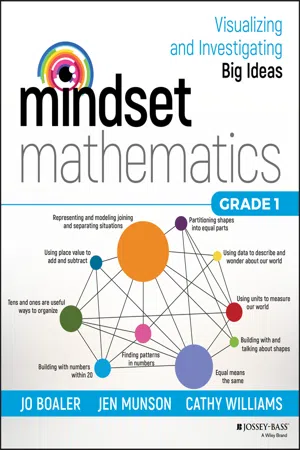
Mindset Mathematics: Visualizing and Investigating Big Ideas, Grade 1
- English
- ePUB (mobile friendly)
- Available on iOS & Android
Mindset Mathematics: Visualizing and Investigating Big Ideas, Grade 1
About this book
Engage students in mathematics using growth mindset techniques
The most challenging parts of teaching mathematics are engaging students and helping them understand the connections between mathematics concepts. In this volume, you'll find a collection of low floor, high ceiling tasks that will help you do just that, by looking at the big ideas at the first-grade level through visualization, play, and investigation.
During their work with tens of thousands of teachers, authors Jo Boaler, Jen Munson, and Cathy Williams heard the same message—that they want to incorporate more brain science into their math instruction, but they need guidance in the techniques that work best to get across the concepts they needed to teach. So the authors designed Mindset Mathematics around the principle of active student engagement, with tasks that reflect the latest brain science on learning. Open, creative, and visual math tasks have been shown to improve student test scores, and more importantly change their relationship with mathematics and start believing in their own potential. The tasks in Mindset Mathematics reflect the lessons from brain science that:
- There is no such thing as a math person - anyone can learn mathematics to high levels.
- Mistakes, struggle and challenge are the most important times for brain growth.
- Speed is unimportant in mathematics.
- Mathematics is a visual and beautiful subject, and our brains want to think visually about mathematics.
With engaging questions, open-ended tasks, and four-color visuals that will help kids get excited about mathematics, Mindset Mathematics is organized around nine big ideas which emphasize the connections within the Common Core State Standards (CCSS) and can be used with any current curriculum.
Frequently asked questions
- Essential is ideal for learners and professionals who enjoy exploring a wide range of subjects. Access the Essential Library with 800,000+ trusted titles and best-sellers across business, personal growth, and the humanities. Includes unlimited reading time and Standard Read Aloud voice.
- Complete: Perfect for advanced learners and researchers needing full, unrestricted access. Unlock 1.4M+ books across hundreds of subjects, including academic and specialized titles. The Complete Plan also includes advanced features like Premium Read Aloud and Research Assistant.
Please note we cannot support devices running on iOS 13 and Android 7 or earlier. Learn more about using the app.
Information
BIG IDEA 1
Building with and Talking about Shapes
What makes a mathematician is not technical skill or encyclopedic knowledge but insatiable curiosity and a desire for simple beauty. Just be yourself and go where you want to go. Instead of being tentative and fearing failure or confusion, try to embrace the awe and mystery of it all and joyfully make a mess. (Lockhart, 2012, p. 10)
Reference
- Lockhart, P. (2012). Measurement. Cambridge, MA: Harvard University Press.
Build(ings)

Snapshot
- 1.G.2, 1.G.1
Agenda
| Activity | Time | Description/Prompt | Materials |
| Launch | 10–15 min | Show students the Noticing Buildings sheet and ask what students think makes these buildings different or the same, then discuss what shapes are used to make the buildings. Support students in noticing different shapes. Connect these two-dimensional shapes to a simple building you have created with blocks, and discuss what shapes are used to make your building. Tell students about the activity and introduce them to the materials available for constructing buildings. |
|
| Explore | 30–45 min | Partners make a plan for the type of building they want to create and the shapes they will need to construct it. Th... |
Table of contents
- Cover
- Table of Contents
- Title Page
- Copyright
- Dedication
- Introduction
- Note on Materials
- Activities for Building Norms
- BIG IDEA 1: Building with and Talking about Shapes
- BIG IDEA 2: Tens and Ones Are Useful Ways to Organize
- BIG IDEA 3: Representing and Modeling Joining and Separating Situations
- BIG IDEA 4: Using Data to Describe and Wonder about Our World
- BIG IDEA 5: Equal Means the Same
- BIG IDEA 6: Building with Numbers within 20
- BIG IDEA 7: Finding Patterns in Numbers
- BIG IDEA 8: Using Place Value to Add and Subtract
- BIG IDEA 9: Using Units to Measure Our World
- BIG IDEA 10: Partitioning Shapes into Equal Parts
- Appendix
- About the Authors
- Acknowledgments
- Index
- End User License Agreement